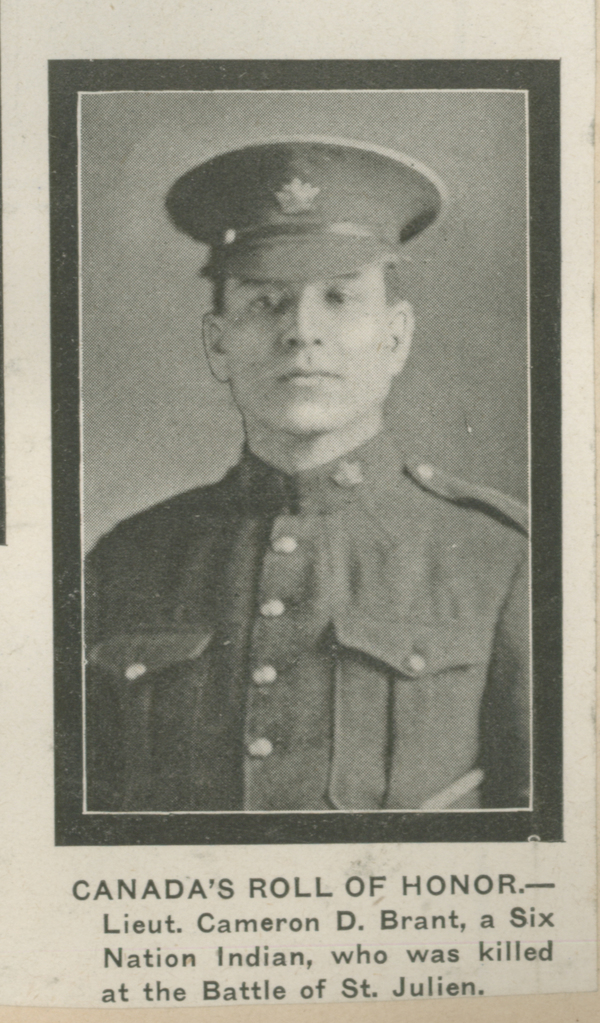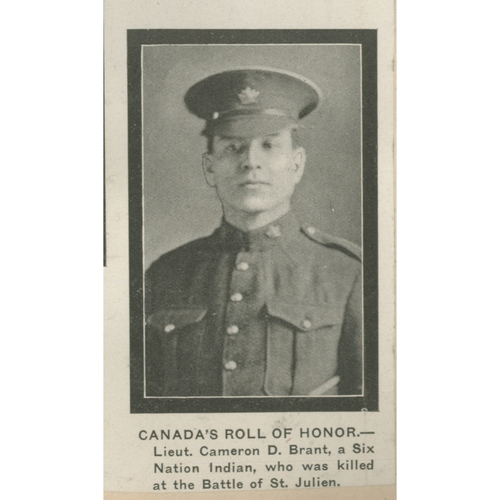
Source: Link
BRANT, CAMERON DEE, sheet-metal worker, soldier, and officer; b. 12 Aug. 1887 in New Credit, Ont., eldest son of Robert Brant and Lydia Lewis; m. 4 July 1911 Florence Phillips in Brantford, Ont.; d. 23 or 24 April 1915 near Ypres (Ieper), Belgium.
On both his parents’ sides Cameron Brant was a great-great-grandson of Joseph Brant [Thayendanegea*], the famous Mohawk war chief. Cameron’s paternal great-grandfather, the son of Joseph Brant, and his paternal great-grandmother, the half-sister of the Reverend Peter Jones*, converted to Methodism. In the late 1820s they moved to live among the Methodist Mississauga Ojibwa at the Credit River, just west of York (Toronto), and they later went to New Credit, beside the Six Nations on the Grand River, after the removal of the Mississauga there in 1847. Brant’s paternal grandparents and his parents became prosperous farmers at New Credit. They strongly supported the local Methodist church, and for several years Brant’s parents hosted camp-meetings at the back of their farm.
Robert and Lydia Brant raised a family of nine. Greatly valuing education, the Brants encouraged their children to obtain as good a one as possible. Cameron himself attended the New Credit school and the Hagersville High School. From a young age he loved all things military, and he avidly read books about war. Shortly after graduating from high school he attended the military school at Wolseley Barracks in London. For six years Brant served in the 37th Regiment (Haldimand Rifles), resigning in January 1912 after he moved to Hamilton to work in a sheet-metal shop. He lived in Hamilton with his bride, a non-native woman from a farm near Hagersville who had attended the New Credit Methodist church.
Three days after Britain’s declaration of war against Germany on 4 Aug. 1914 Brant signed up as a private in the Canadian Expeditionary Force; he is believed to have been the first member of the Six Nations to enlist. While in camp at Valcartier, Que., he was commissioned, and as Lieutenant Brant of the 4th Infantry Battalion he left for Britain with the first Canadian contingent on 3 October. After training on Salisbury Plain, his unit was sent to France in February 1915. Quickly the “quiet and unobtrusive” officer won the confidence of his men. The commanding officer of his battalion reported in mid March, “The boys will follow him everywhere.” In the Canadians’ first major engagement, the battle of Ypres in April, Brant bravely led his men in the face of the fierce German attack, which was preceded by the release of poison gas. He died in combat on the 23rd or the 24th. His body was not recovered.
Brant was among the first of nearly 300 men from the Six Nations community who enlisted in the Canadian army during World War I and the first of 30 killed in action. In a testimonial prepared by the mayor of Brantford and other local notables, Brant County honoured him, as did the hereditary council of the Six Nations. At New Credit the Mississauga in 1919 erected a memorial tablet in the Methodist church to Lieutenant Cameron D. Brant, the Mohawk warrior who had lived and worshipped amongst them.
[Family information was obtained by the author from Joseph Brant of New Credit, Ont., a younger brother of the subject, in interviews of 1 May 1993 (by telephone) and 4 June 1993 (at his home), and from the late Mrs Effie Brant Montour, a younger sister, who was interviewed at a seniors’ residence in Oakville, Ont., on 10 June 1978. The author also wishes to thank Denise Kirk, local history librarian with the Brantford Public Library (Brantford, Ont.), for providing the newspaper references which follow. d.b.s.]
NA, MG 30, E43; RG 150, Acc. 1992–93/166. Brantford Weekly Expositor, 6 July 1911; 6, 13 May 1915. Daily Expositor (Brantford), 26 April, 1 May 1915. Can., Dept. of Indian Affairs, Annual report (Ottawa), 1929/30: 15–22. D. G. Dancocks, Welcome to Flanders fields; the first Canadian battle of the Great War: Ypres, 1915 (Toronto, 1988). A. L. Hatzan, The true story of Hiawatha and history of the Six Nation Indians (Toronto, 1925). E. T. Montour, The feathered U.E.L.’s; an account of the life and times of certain Canadian native people (Toronto, 1973). D. C. Scott, “The Canadian Indians and the Great World War,” in Canada in the Great World War; an authentic account of the military history of Canada from the earliest days to the close of the war of the nations (6v., Toronto, [1917–20]), 3: 297–303 (photo of Brant facing p.300). D. B. Smith, Sacred Feathers: the Reverend Peter Jones (Kahkewaquonaby) and the Mississauga Indians (Toronto and London, 1987). G. J. Smith, “Capt. Joseph Brant’s status as a chief, and some of his descendants,” OH, 12 (1914): 89–101. S. M. Weaver, “The Iroquois: the Grand River reserve in the late nineteenth and early twentieth centuries, 1875–1945,” in Aboriginal Ontario: historical perspectives on the First Nations, ed. E. S. Rogers and D. B. Smith (Toronto and Oxford, 1994), 213–57; “Six Nations of the Grand River, Ontario,” in Handbook of North American Indians, ed. W. C. Sturtevant et al. (9v. to date [4–11, 15], Washington, 1978– ), 15: 525–36.
Cite This Article
Donald B. Smith, “BRANT, CAMERON DEE,” in Dictionary of Canadian Biography, vol. 14, University of Toronto/Université Laval, 2003–, accessed December 31, 2025, https://www.biographi.ca/en/bio/brant_cameron_dee_14E.html.
The citation above shows the format for footnotes and endnotes according to the Chicago manual of style (16th edition). Information to be used in other citation formats:
| Permalink: | https://www.biographi.ca/en/bio/brant_cameron_dee_14E.html |
| Author of Article: | Donald B. Smith |
| Title of Article: | BRANT, CAMERON DEE |
| Publication Name: | Dictionary of Canadian Biography, vol. 14 |
| Publisher: | University of Toronto/Université Laval |
| Year of publication: | 1998 |
| Year of revision: | 1998 |
| Access Date: | December 31, 2025 |



